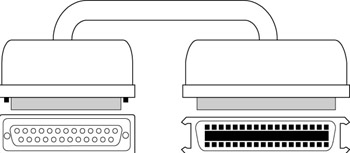Parallel Ports and Connectors
|
| < Day Day Up > |
|
A parallel port, otherwise referred to as LPT1 or LPT2, is an external interface associated with the IEEE 1284 standard that is used to connect a computer to peripheral devices such as printers, CD-ROM players, scanners, or tape unit devices. Figure 8.1 shows a standard parallel port on the back of a system unit. A parallel port uses parallel transmission methods to transmit or send data one byte at a time to a peripheral device. A parallel cable has eight internal wires, and each wire is capable of sending one bit of information at a time. (Remember, there are eight bits in one byte.) Information is transmitted eight bits across all at once, for a total of one byte, in only one direction at a time using parallel transmission.
It is important to note for the core exam that parallel transmission methods are faster than serial transmissions. Serial transmission methods will be discussed shortly.
A parallel port on the back of a computer system is a female DB-25 connector that accepts a DB 25-pin male connector on one end of a parallel cable. The other end of a parallel cable has a 36-pin male Centronics D-shell connector that connects to a Centronics connector located on the back of a printer or device. Figure 8.2 shows the connectors on both ends of a typical parallel printer cable. Printer and scanner Centronics connectors typically use two clips to secure the connector to the port located on the back of the device. In addition, it is important to note that a parallel cable can also be used to connect or network two computers together.

Figure 8.2: A parallel printer cable.
To ensure that the signals traveling down a parallel wire do not become distorted, the length of a parallel cable should not exceed 10 feet. Remember for the core exam that parallel transmission occurs 1 byte at a time.
The newest addition to the IEEE 1284 standard for bidirectional communications and printing is the Type C-Mini 36-pin parallel connector. Also known as 'Half Pitch Centronics36 connectors,' these compact-size parallel connectors are often used with laptops and some newer printers. The Type C-Mini 36-pin parallel connector also provides support for Enhanced Parallel Port (EPP) applications.
| Note | The Type C-Mini 36-pin connector has been identified as one of the A+ 2003 Objective additions. Make sure that you are aware that this is an IEEE 1284 Mini 36-pin parallel connector with clip latches, which provides support for EPP applications. |
In concluding our discussion of parallel cables and connectors, there are three types of parallel connections that you should be familiar with. They are:
-
Type A. This is a DB-25 male or female connector that uses thumbscrews.
-
Type B. This is the standard Centronics 36-pin ribbon connector plug.
-
Type C. This is the Mini 36-pin Centronics connector plug with clip latches.
The following RAM Electronics Industries, Inc. Web site offers some very good images of the three main parallel connector types as well as many of the other connectors mentioned in this chapter: http://www.ramelectronics.net/html/connecters.html
|
| < Day Day Up > |
|
EAN: 2147483647
Pages: 237